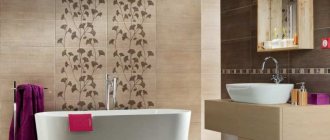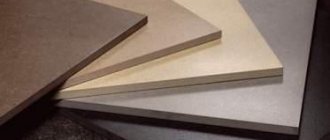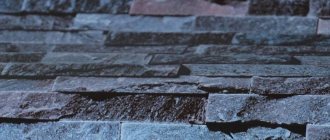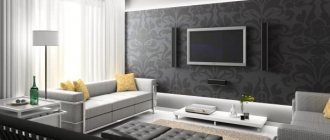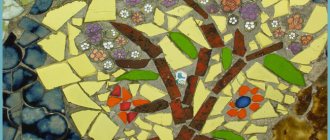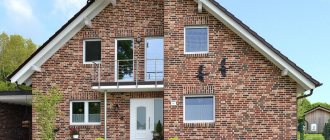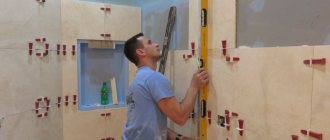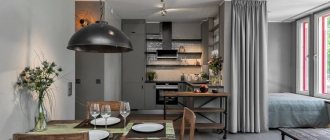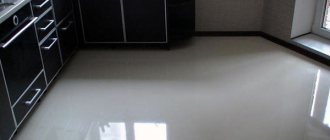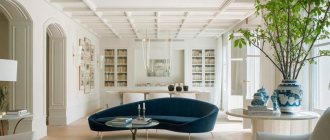Self-leveling flooring in an apartment is one of the latest trends that has earned recognition among designers. This floor design option is considered very popular; it quickly won the love of people for its attractive appearance and high performance properties of the materials used.
Self-leveling flooring is not cheap, but the high aesthetic characteristics of the coating tip the scales in its favor
To create a liquid floor structure, polymer compounds are used that have a mirror effect. This solution allows you to visually expand the room, as well as think through many other design moves. The flooring plays a decisive role in the complete design of the room, and is also the finishing touch and highlight.
Features of using self-leveling flooring in apartment design
There are many options for designing poured floors in an apartment. There are not only monochromatic coatings. A large number of different modern materials allows you to realize any fantasies. You can choose the right solution for any style and for a variety of rooms.
Self-leveling floor with a picture of colored pebbles
Floors with various patterns are widely popular. They are created using polymer paints. It is also possible to fill the base with shells, pebbles, and other decorative elements. The design with a 3D effect looks interesting, creating an entire composition. Using available tools and techniques, you can create a real masterpiece of art in your apartment. You will definitely please your family and surprise your friends with such delights.
A properly selected self-leveling floor can become the main decorative element of a room’s interior.
Intricate patterns or dramatic 3D images look best in rooms with minimal furniture.
When choosing a pattern for a self-leveling floor, you should take into account that an unusual pattern can get boring, and replacing such a coating is very problematic
Plain floors are the best solution for apartments with a small amount of square meters. Among the features, the following should be noted:
- one color will fit perfectly into any design solution, and will also allow you to implement various ideas for decoration;
- you can make an advantageous accent using contrast and periodically change the color of certain details;
- do not attract much attention to themselves, creating an unnoticeable final touch to the interior design;
- you can visually expand the space using light colors.
You can create any composition using the materials at hand.
The artistic design of self-leveling floors implies a wide variety of options. The photo shows an example of a floor for a room in the pop art style
Contrasting self-leveling floor with an original pattern
Light inside the plane
If you need to create the feeling of a podium, lighting or a flying surface, consider the option of a self-leveling glossy floor in light shades. Milk, brie, champagne - these and other neutral tones create perspective.
It’s as if light is hidden inside such a covering. This is an optical effect that is convenient to use and play with in different ways. You can reinforce it with furnishings in light, soft natural tones and velvety textures. For example, textiles: carpets, rugs. As well as natural materials and unusual finishes: wooden doors, light-colored plaster moldings, light Wainscot.
If the room has panoramic glazing or streams of light enter the room through the roof or veranda, the idea can be implemented in a minimalist manner. For example, leave the brickwork, make a light-colored self-leveling floor, and include only the necessary interior items in the design. In the evening, you can maintain the effect with spot lighting. For example, garlands or track lights.
Turquoise and stucco together with self-leveling floor and brick wall
Advantages and disadvantages of self-leveling floor
You can study a photo of the poured floor in the apartment to get a rough idea of the appearance of the coating. Among its advantages, it should be emphasized:
- absence of any seams - the coating is perfectly smooth, without flaws;
- the ability to implement various decorative solutions;
- wide color palette;
- wear resistance - the coating can withstand heavy weight, does not scratch, and does not lose its aesthetic properties;
- there are no difficulties during maintenance - you can wash with any detergent without fear of damaging the surface;
- high practicality of the polymer - it does not lend itself to moisture, which allows it to be used even in the kitchen or bathroom;
- the material is safe for human health - during operation you will not feel any unpleasant odors or any toxic emissions;
- does not burn, has good waterproofing;
- can be used as a base for another coating, as it allows you to create a perfectly flat surface.
Depending on the type of surface, the self-leveling floor can be glossy, matte or semi-gloss
Matte self-leveling floor - non-slippery
Among the disadvantages you should pay attention to the following:
- the coating is cold, so additional heating will be required in winter - you can introduce a heated floor system;
- is considered an old-fashioned solution - with the exception of options with different decorative elements;
- does not create a cozy atmosphere in the apartment;
- has a high cost, so it is not suitable for every buyer; sensitive to sunlight.
Basically, self-leveling floors are used as a rough covering, as they allow you to make the surface perfectly flat. After this, other coatings are applied.
The thickness of the thin-layer self-leveling floor does not exceed 5 mm. This coating is the most inexpensive and is suitable for rooms with low humidity levels.
Highly filled coatings are suitable for leveling surfaces with small differences in height and consist of several layers with a minimum thickness of 5 mm. A variation of this system is 3D floors
Varieties
There are a lot of flooring options. And there are different classifications too. For example, self-leveling floors can be classified according to the materials from which they are made:
- cement-acrylic flooring is made from special building mixtures;
- Epoxy is based on resins;
- methyl methacrylic resins are the basis of self-leveling floors of the same name;
- Polymers are based on various polymer compositions.
According to their composition and manufacturing method, they can be one-component or two-component. One-component compositions have a small range of colors. They are used more often for utility rooms. Such floors usually attract not their artistic advantages, but other positive qualities. They create a perfectly smooth and durable coating, are durable and hygienic.
Self-leveling floor with dolphins
For one-component self-leveling floors, water-soluble materials and building mixtures are used. The technology for their creation is quite simple; you can make them yourself. Two-component flooring options can be available in any color according to the RAL scale. Moreover, they can be transparent or opaque. The decorative possibilities of such technologies are very extensive.
The most common options are combinations of transparent and opaque layers. Additionally, pigmentation is used, interspersing various kinds of construction chips and other artistic techniques. The top is filled with transparent polymer varnish.
Two-component compositions allow you not only to create any artistic images, but also to make the floor shiny, shimmering under the influence of light or sunlight. Advantages:
- continuous surface without seams or joints;
- high strength and abrasion resistance;
- all components of self-leveling floors are non-toxic;
- they are hygienic, bacteria do not multiply on them, and they do not attract dust;
- self-leveling floors have anti-slip properties;
- monolithic coating guarantees a high level of waterproofing;
- The 3D poured floor is fireproof, it does not support combustion;
- artistic floors do not lose their brightness when exposed to ultraviolet rays;
- they allow you to create a perfectly harmonious room design;
3D self-leveling floors with fish
Most popular images
One of the most fashionable image options for self-leveling floors today is the use of plain openwork inserts on a white glossy background. This floor is made from an opaque white base layer. The final coating is made of transparent materials.
In small rooms, such as the bathroom, small images are more often used. This could be a view of an exotic seabed with fish, pebbles and bright, unusual vegetation. For a room that is too crowded with furniture, it is better to choose designs with a minimum number of objects. Often this is a monotonous image, for example, granite or linen fabric, cork, etc.
In a large room, the images on the floor may be large. It can be a real plot picture or a convex geometric pattern, beautiful pictures of nature. You can also make an artistic floor with an imitation of any other floor covering. For example, under tiles, parquet, stone, etc. Stylization is often done to match the basic design of the room. For example, in loft style, shabby chic, hi-tech or any other style.
Main types of self-leveling floor
There are several different types of self-leveling floors depending on the composition of the mixture. Below are the most common options.
Dry one-component mixtures are diluted with water in a certain proportion immediately before use.
Two-component compositions include a base and a hardener, mixed before starting work.
Epoxy
This design is rigid and durable, but easily crumbles upon impact. It can be used in wide temperature ranges, which makes it popular in various areas of human activity.
Epoxy self-leveling flooring is safe and hygienic
Fragility is one of the important indicators that should be taken into account during the installation process. If you do not follow the technology, the floor will become covered with cracks, which will only lead to unnecessary spending of money on additional repairs.
Epoxy-urethane
It combines the characteristics of epoxy and urethane materials, which makes them quite common and in demand. It is characterized by high stability, strength, and elasticity. Often used in parking lots and large retail spaces to create a beautiful, smooth surface.
Combined epoxy-urethane flooring combines high strength with sufficient elasticity
Polyurethane
Has high aesthetic indicators. Used for finishing flooring. It is resistant to heavy loads, as well as high performance.
Polyurethane flooring is suitable for rooms with high humidity
The composition does not contain harmful or toxic substances. Durability and quality make this type of coating popular for installation in public places. Does not lose its properties over a long period of time.
Cement-acrylic
They are most often used in large industrial enterprises. They are strong enough to withstand the daily wear and tear of heavy equipment.
The cement contained in the cement-acrylic screed ensures high strength of the coating.
It is resistant to various chemical influences. Can level surfaces with large defects. Does not have high aesthetic properties. Used where practicality is important.
Polymer
The material is used most often. It is the ideal combination of quality and aesthetic properties. Installed in apartments and offices. Has a large number of different design options.
The characteristics of a polymer self-leveling floor are determined by the polymer components included in it.
Metal methacrylate
It is not stable, but hardens quickly. Allows you to use the room within a few hours after pouring. The surface does not slip.
Methyl methacrylate screed is resistant to chemicals, ultraviolet radiation and temperature changes
Application area
The absence of joints and gaps explains the wide range of applications. For example, in medical institutions, where a lot of attention is paid to the cleanliness and treatment of surfaces, this is one of the most popular types of flooring.
Along with the design of premises, there is already considerable experience in using it outdoors, for covering steps and sidewalks. The self-leveling flooring system is so durable and wear-resistant that it can be used in a garage or warehouse where there is a high risk of damage.
Fire resistance and resistance to permanent damage justify its presence in shopping centers and other public places.
Photo: Self-leveling floor in the interior of the apartment
How to care?
In terms of operation of self-leveling floors, there are no special requirements. However, in order to maintain their attractiveness for many years, it is recommended to regularly treat the surface with a special mastic. It is applied in a thin layer at least every six months. When performing repairs, it is advisable to cover the coating with thick fabric or other material.
In the “Cozy Wall” studio you can order photo wallpapers for arranging rear floors in any style with delivery throughout the Russian Federation. Our catalog has a large selection of popular designs in various categories and the ability to create images based on client sketches.
Pouring the composition
Base primer
Having removed the loose layer of concrete, sealed all the cracks, and removed dust from the surface with a vacuum cleaner, the base should be primed, thereby reducing the consumption of the base material, creating conditions for its better spreading over the surface and increasing its adhesive properties. An edge strip should be laid along the perimeter of the walls.
Preparation of the solution
Preparation of the solution will take no more than half an hour and must comply with the manufacturer's recommendations.
A ready-to-use solution must be used immediately after preparation, otherwise its properties will deteriorate.
Checking the solution for spreadability
If, when making a self-leveling floor with your own hands, you doubt the amount of liquid per bag of material, it is recommended to check the level of spreadability of the finished mixture. This can be done using a simple technique:
- Cut a ring from a five-liter plastic bottle, the diameter of which is 20 cm;
- Place it on a pre-cleaned glass or ceramic surface;
- Pour the prepared liquid solution into the ring;
- Pick up the ring.
If the solution, after removing the limiter, spreads on a surface with a diameter of about 60 cm, that is, three times the diameter of the bottle ring, you have found the optimal amount of liquid.
The key to good spreadability of the mixture is the correct consistency of the solution, which is obtained by strictly observing the proportions recommended by the manufacturer
Installation technique of work
At this point you will need floor tape. It should be laid around the perimeter of the room, fixing the walls in places of contact with the future polymer screed. The presence of tape will help to avoid deformations and cracks after drying the coating, since this compensates for the expansion of the material. The thickness of the damper must correspond to the thickness of the coating. If you choose a thin layer of filler, the thickness of the tape should be small. Ideally, it should not be visible after the coating has dried. If part of the tape is visible above the floor surface, you should cover it with baseboards.
After applying the tape, cleaning and preparing the substrate, prime it. It is best to choose a deep-penetrating primer for self-leveling floors. To apply, use a roller. Before the next step, you must wait until the primer layer is completely dry. If the screed is old and porous, for reliability you need to apply a primer in 2-3 layers. The new screed may harden after one application.
If you are leveling a bathroom floor and plan to install ceramic tiles on it, it is especially important to create a base level. On a not entirely level screed, the tiles may begin to crack, break and then burst. After installing the beacons, spread the solution with a spatula, filling all the voids between the beacons and the base. Wait for the cement mortar to dry, then begin preparing the dry polymer mixture for pouring.
Surface preparation
When screeding the floor with a special solution, there is no need to additionally prepare the surface, since the filling is done in a thick layer.
Self-leveling floors require careful preparation and cleaning of the surface.
Arrangement of beacons
Fill the screed, focusing on the beacons. Most mixtures have self-leveling properties under their own weight and do not require beacons.
Using rack or pin beacons when pouring
